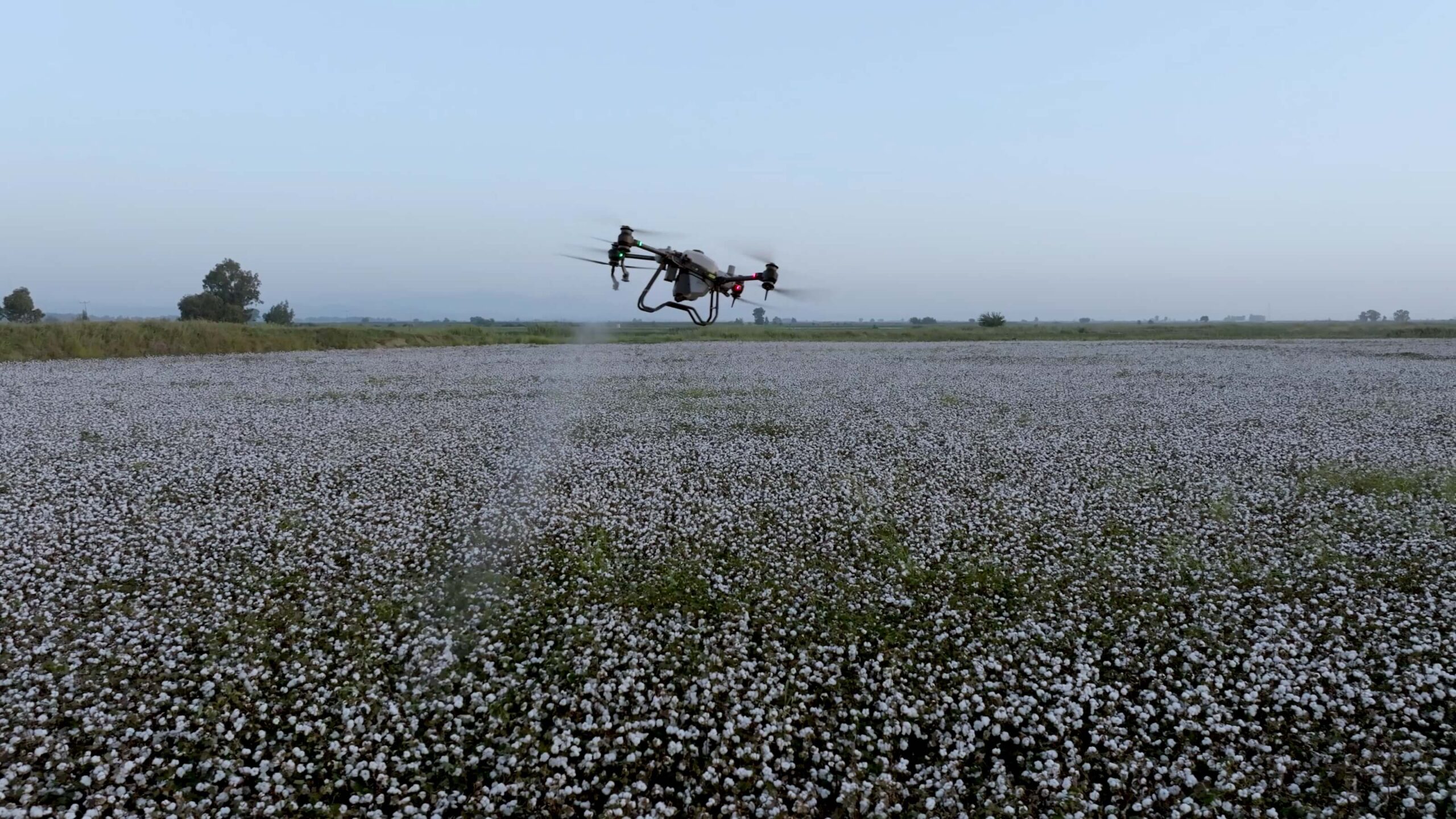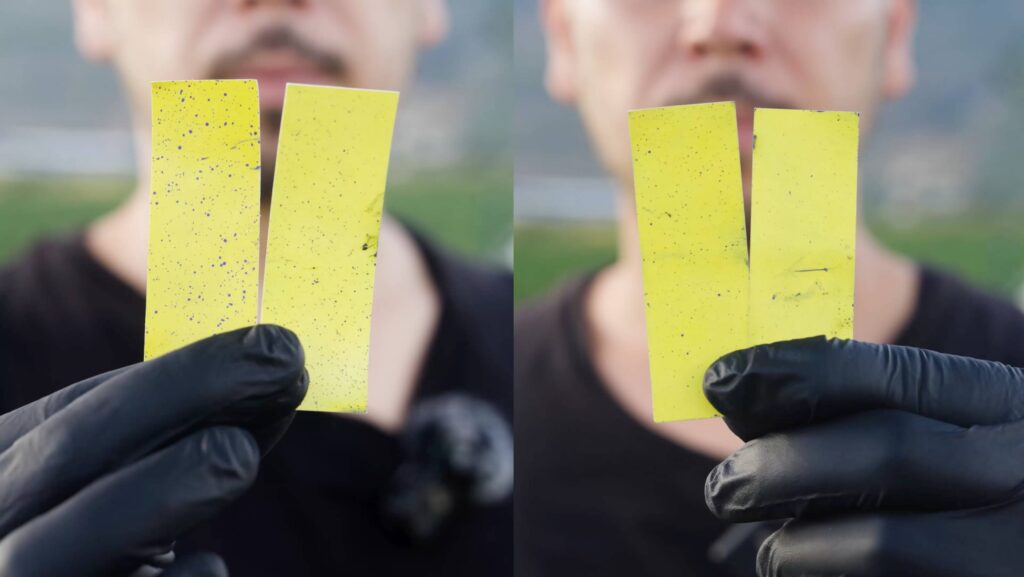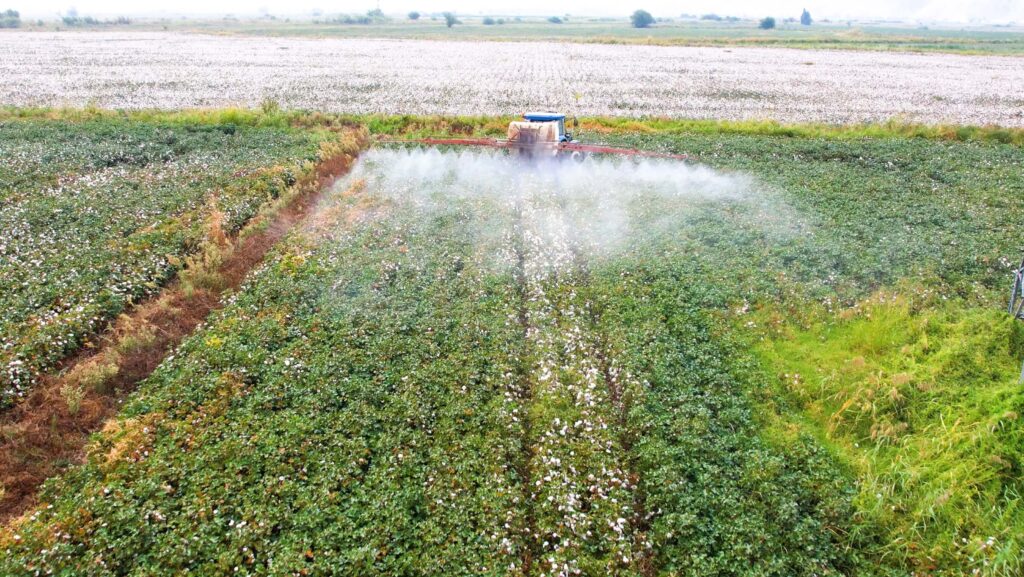
Cotton Farming with DJI Agriculture Drone Solutions
A complete solution guide for using DJI Agriculture drones when farming cotton
Cotton, a staple in the textile and fashion industry, has a rich and extensive history that dates back thousands of years. Today, cotton is so ubiquitous that it’s almost invisible. According to the Food and Agriculture Organization of the United Nations (FAO) statistics in 2021, over 70 countries are currently planting cotton, with a harvested area of 32.5 million hectares and production amounting to 72.6 million tons of seed cotton (unginned).
As the global population continues to grow, so does the need for more efficient and sustainable farming methods. Ground sprayers have been the go-to tool for cotton spraying for years, but they come with their own set of challenges – from poor penetration and coverage to wheel track damage.
With these issues in mind, the drone solution is becoming increasingly popular and necessary in cotton farming. In this blog, we will explore how DJI Agriculture drones are transforming the cotton farming industry, delivering higher efficiency, lower costs, and even better crop health.

Benefits of DJI Agriculture Drones for Cotton Farming
DJI Agriculture drones provide a myriad of advantages over the traditional ground sprayer approach. Here are some of the key benefits:
1. Better Coverage and Spray Effect
DJI Agriculture drones are specifically engineered to ensure comprehensive and consistent coverage on all parts of the plant. This feature eliminates common struggles faced by farmers such as poor penetration on lower leaves or uneven application of agrochemicals.
The drone’s propellers generate a powerful downwash wind flow. This wind flow propels the droplets downward, ensuring they reach the bottom of the canopy. As a result, the agrochemicals can blanket the entire plant, providing more effective coverage.
This superior coverage was clearly demonstrated in a comparison test conducted by Ümit Göven, a Turkish agrochemical seller and cotton farmer, and Daze Tarim, a DJI dealer in Turkey. They placed water-sensitive paper at the bottom of the cotton in two fields. One field was sprayed with a ground sprayer and the other with a drone. The water-sensitive paper from the field sprayed by the drone showed higher droplet density and better coverage, indicating superior spraying efficacy.


The benefits are especially evident when applying defoliants. In Ümit’s cotton field sprayed with a drone, the harvest began just 8 days after defoliant spraying. In contrast, the field sprayed with a ground sprayer only started harvesting after 15 days. This acceleration of the harvest process by 7 days allows the cotton yield to be protected from adverse weather conditions.
2. Higher Efficiency
DJI Agriculture drones deliver superior efficiency through faster and more precise application techniques. They can cover more ground in less time, leading to significant reductions in labor costs and substantial increases in overall productivity.
The drone achieves this efficiency through its ultra-low volume spraying method and quick turnover between chemical refilling. For instance, a T40 drone can spray approximately 16 hectares of a cotton field in just one hour. In contrast, a New Holland TD 100D with a 14.6-meter wide spray boom, a common setup for a 100-hectare cotton field, can only spray about 7-8 hectares within the same timeframe. This means that the drone’s spraying efficiency is twice as high as that of the ground sprayer.
This time saving not only reduces labor and machine costs but also ensures timely control of insect damage. Therefore, using DJI Agriculture drones leads to higher efficiency and productivity in crop management.
Tractor and drone specs and parameters are shown in Table 1.
3. Lower Cost
Drone applications can lead to significant savings on labor, fuel, and other input costs when compared to traditional ground sprayer methods.
This is largely due to the ultra-low volume spraying capability of drones and the fact that they operate uncrewed. For example, the diesel consumption for a ground sprayer is approximately 2.5L per hectare. In contrast, the petrol consumption for a drone like the T40 (equipped with a DJI generator) is just 0.2 L per hectare. This difference results in a cost saving of approximately $2.82 USD per hectare.
To put this into perspective, consider Ümit’s cotton field which spans 250 hectares. A tractor would require 625 liters of diesel to cover the entire field. However, a DJI D12000iE generator would only need 50 liters of petrol to charge the drone batteries for the same task. Given the prices of diesel and petrol on Dec 13, 2023, in Turkey, (35.43 Turkey Lira/liter of diesel and 32.98 Turkey lira/liter of petrol) the savings from using a drone are considerable.
| Tractor | New Holland TD 100D | Drone | T40 |
| Application rate | 200~300 L/ha | Application rate | 10-20 L/ha |
| Horsepower | 100 hp | Height above crop | 3-3.5 meters |
| Sprayer width | 14.6 meters | Route spacing | 7-7.5 meters |
| Tractor speed | 10 km/h | Flight speed | 25 km/h |
| Efficiency | 8 ha/hour | Efficiency | 16 ha/hour |
| Fuel consumption | 2.5 L/ha | Fuel consumption | 0.2 L/ha |
4. No Damage to the Cotton
One of the significant advantages of using drones is that they do not cause any damage to the cotton. Unlike traditional farming methods that involve driving machinery through the fields, drones avoid damaging plants through wheel track compaction and even reduce soil compaction.
Once the canopy is closed, driving a tractor into the field can crush the cotton, causing significant damage. However, by using a drone for spraying, the cotton is saved from this wheel track damage. According to Murat, a cotton farmer from Turkey, up to 12%* of cotton could be saved from wheel track, which is approximately 600 kg and $414 USD saved per hectare.

Wheel track damage percentage is calculated by dividing the track width per row by the number of rows for the entire application, then dividing this by the total field area.
Considering the average cotton yield of 5000 kg per hectare and the 2023 average price for unginned seed cotton being 20 Turkish lira per kg, the savings from using drones are substantial. Therefore, using drones in agriculture not only increases efficiency but also prevents unnecessary loss and damage to crops.
5. Post-Rain Spraying
DJI Agriculture drones have a distinct advantage over traditional ground sprayers in that they can operate even after rainfall. Ground sprayers often get stuck in the mud following rain, causing delays in critical application schedules. However, DJI Agriculture drones are able to continue operations, preventing such delays.
Post-rainfall conditions pose a significant challenge for tractors as the field becomes slippery and soft. The soil needs to be solid enough for a tractor to navigate. In cases of severe insect infestations, any delay can lead to increasing losses, which are calculated by the second. However, drones can spray after rain when the soil conditions are unsuitable for tractors. This ability to operate under adverse conditions ensures that crop protection measures are not delayed, thereby minimizing potential losses. This is yet another way in which drones offer superior performance in agricultural applications compared to traditional methods.
6. Variable Rate Spraying
DJI Agriculture drones are equipped with the capability to conduct variable rate spraying. This feature allows farmers to optimize product application based on specific field conditions, leading to reduced waste and improved crop health.
A common practice in cotton farming is the use of growth regulators like Pix. These chemicals are sprayed on cotton fields to curb excessive cotton growth and focus more on boll development. Rather than applying these chemicals at a flat rate across the entire field, variable rate spraying allows for a more targeted approach.
With variable rate spraying, regions of excessive growth can receive a higher rate of Pix, while areas with weaker growth receive a lower rate. This targeted application has the potential to increase cotton yield significantly.

This level of precision in chemical application can be achieved with a DJI product package that includes the M3M, SmartFarm Web or Terra, and an AGRAS drone. These tools work together to provide a highly efficient and cost-effective solution for modern agriculture. By leveraging these advanced technologies, farmers can ensure optimal crop health and productivity.
Drone Application Opportunities in Cotton Farming
In Turkey, for instance, drones can be used to spray cotton five times throughout the growing season, with applications at different stages of growth:

- V0 – V2: Herbicide & Fungicide
- V3 – BN: Herbicide & Fungicide & Foliar Fertilizer
- F1 – FN: Insecticide & Growth Regulator
- FN – C1: Insecticide & Foliar Fertilizer & Growth Regulator
- After C1: Defoliant
This targeted drone application strategy ensures that cotton plants receive the right treatments at the right time, for optimal results.
Best Practices for Drone Cotton Spraying
Below, we provide recommendations for which drones, and how to fly them, when treating your cotton.
Recommended Flight Parameter Settings
Herbicide & Insecticide & Fungicide & Growth Regulator & Defoliant
| T40 | T20P | T30 | T10 | Notes | |
| Application Rate (L/ha) | 10~20 | 10~20 | 10~20 | 10~20 | Please refer to your agronomist’s suggestion |
| Droplet size (μm) | 100~300 | 100~300 | Nozzle model: 11001 | Nozzle model: 11001 | Please choose coarse droplet size if drift risk is high such as spraying herbicide and/or spraying in windy conditions. |
| Flight speed (km/h) | 18~25 | 20~25 | 18 ~ 21.6 | 14~20 | Please decrease flight speed when drift risk is high such as when spraying herbicide, and when there are plenty obstacles in the field. |
| Route spacing (meter) | 7~9 | 5.5~6.5 | 5.5~6 | 3.8~4.2 | Route spacing that is too wide or too narrow will cause striping. |
| Height above the crop (meter) | 3~3.5 | 2.5~3 | 2.2~2.5 | 1.8~2.2 | Please decrease flight height if drift risk is high such as spraying herbicide and/or spraying in windy conditions. Increase flight height if crop damage caused by propeller downwash is a concern. |
Foliar Fertilizer
| T40 | T20P | T30 | T10 | Notes | |
| Application Rate (L/ha) | 10~20 | 10~20 | 10~20 | 10~20 | Please refer to your agronomist’s suggestion |
| Droplet size (μm) | 100~300 | 100~300 | Nozzle model: 11001 | Nozzle model: 11001 | Please choose coarse droplet size if drift risk is high such as spraying herbicide and/or spraying in windy conditions. |
| Flight speed (km/h) | 25~36 | 25~30 | 25~30 | 15~22 | Please decrease flight speed when drift risk is high such as when spraying herbicide, and when there are plenty obstacles in the field. |
| Route spacing (meter) | 9~9.2 | 6~7 | 6~7 | 3.5~4.5 | Route spacing that is too wide or too narrow will cause striping. |
| Height above the crop (meter) | 3~3.5 | 2.5~3 | 3~3.5 | 2~3 | Please decrease flight height if drift risk is high such as spraying herbicide and/or spraying in windy conditions. Increase flight height if crop damage caused by propeller downwash is a concern. |
M3M Parameter Setting
| Mission Type | Area (2D) | Route height | 180m |
| Route speed | 15 m/s | Attitude optimization | Off |
Relevant Video
To see how drones are used to aid in cotton farming, watch this case study: https://youtu.be/30iNf3o24Uw?si=6w89jKRAtx2DXbau
Warn prompt: Τhe content and parameters provided here are just for your reference. You should adjust the operation mode and the parameters and use a correct way to spray your field according to the different weather, the crop characters, the habit or history of using chemicals (you could change other chemicals in case that the resistance occurs), etc. If you are not sure what operation parameters you will choose or not sure about the spraying efficacy, then you should firstly do a small plot test in this field before a big area spray.
